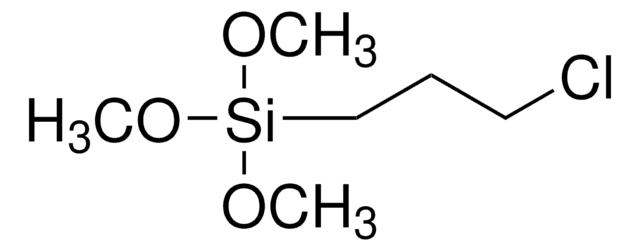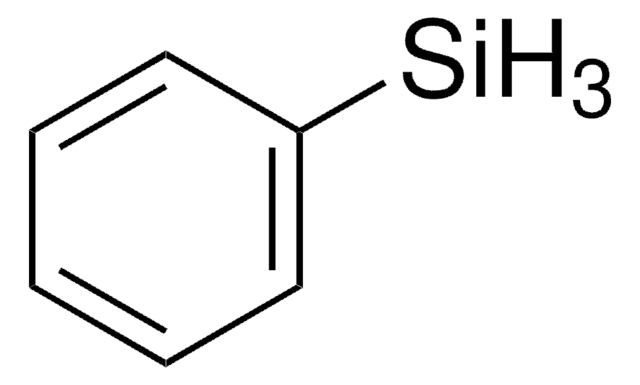438340
Trimethoxy(2-phenylethyl)silane
98%
Synonym(s):
(2-Phenylethyl)trimethoxysilane
Sign Into View Organizational & Contract Pricing
All Photos(1)
About This Item
Linear Formula:
C6H5CH2CH2Si(OCH3)3
CAS Number:
Molecular Weight:
226.34
Beilstein:
3031224
EC Number:
MDL number:
UNSPSC Code:
12352103
PubChem Substance ID:
NACRES:
NA.23
Recommended Products
Quality Level
Assay
98%
form
liquid
refractive index
n20/D 1.475 (lit.)
bp
95-96 °C/2 mmHg (lit.)
density
1.033 g/mL at 25 °C (lit.)
SMILES string
CO[Si](CCc1ccccc1)(OC)OC
InChI
1S/C11H18O3Si/c1-12-15(13-2,14-3)10-9-11-7-5-4-6-8-11/h4-8H,9-10H2,1-3H3
InChI key
UBMUZYGBAGFCDF-UHFFFAOYSA-N
Looking for similar products? Visit Product Comparison Guide
General description
Trimethoxy(2-phenylethyl)silane (TMPES) is a phenyl functionalized trialkoxy silane that can be used as a siloxane based precursor.
Application
TMPES can be used as a silane-based coating on quantum dot (QD) light emitting diodes to improve the adhesion of QDs and improve the thermal stability of the device. It may be used in the synthesis of pure silica zeolite molecular sieves.
Signal Word
Warning
Hazard Statements
Precautionary Statements
Hazard Classifications
Eye Irrit. 2 - Skin Irrit. 2 - STOT SE 3
Target Organs
Respiratory system
Storage Class Code
10 - Combustible liquids
WGK
WGK 3
Flash Point(F)
222.8 °F - closed cup
Flash Point(C)
106 °C - closed cup
Personal Protective Equipment
dust mask type N95 (US), Eyeshields, Gloves
Choose from one of the most recent versions:
Already Own This Product?
Find documentation for the products that you have recently purchased in the Document Library.
Quantum dot-layer-encapsulated and phenyl-functionalized silica spheres for highly luminous, colour rendering, and stable white light-emitting diodes
Yoo H, et al.
Nanoscale, 7(30), 12860-12867 (2015)
Hydrolysis-condensation kinetics of different silane coupling agents
Brochier S, et al.
Phosphorus, Sulfur, and Silicon and the Related Elements, 186(2), 240-254 (2011)
Organic-functionalized molecular sieves as shape-selective catalysts
Jones CW, et al.
Nature, 393(6680), 52-52 (1998)
Brandy J Johnson et al.
Sensors (Basel, Switzerland), 11(1), 886-904 (2012-02-22)
The development of porphyrin-embedded mesoporous organosilicate materials for application to the detection of volatile hydrocarbon solvents is described. Design of the receptor and optical indicator construct begins with parallel selection of the porphyrin indicator and design of the mesoporous sorbent.
Emre Seyyal et al.
Analytica chimica acta, 964, 96-111 (2017-03-30)
Principles of sol-gel chemistry were utilized to create silica- and germania-based dual-ligand surface-bonded sol-gel coatings providing enhanced performance in capillary microextraction (CME) through a combination of ligand superhydrophobicity and π-π interaction. These organic-inorganic hybrid coatings were prepared using sol-gel precursors
Our team of scientists has experience in all areas of research including Life Science, Material Science, Chemical Synthesis, Chromatography, Analytical and many others.
Contact Technical Service









